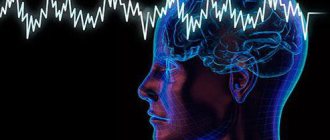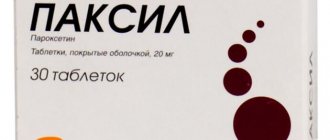Has restrictions during pregnancy
Has restrictions when breastfeeding
Prohibited for children
Prohibited for older people
Prohibited for liver problems
Has limitations for kidney problems
A complete cure for epilepsy is impossible today, but there are many drugs that help minimize the negative symptoms of the disease. Thus, according to the instructions for use, Lamotrigine Canon has an anticonvulsant, antipsychotic effect - this allows the drug to be successfully used for epileptic seizures, bipolar disorders of the nervous system, as well as to prevent the occurrence of foci of hyperexcitability in the cerebral cortex during epilepsy.
General information about the drug
Lamotrigine was originally developed as a folic acid antagonist, but its inhibitory effect on the nervous system was noted, which led to a more detailed study of the mechanism of transformation of the active substance in the body.
Drug group, INN, scope of application
The international nonproprietary name (INN) is Lamotriginum, which coincides with the pharmacological name of the drug. Belongs to the group of anticonvulsants, as well as to the group of antiepileptic drugs - blockers of sodium voltage-dependent channels.
Mechanism of action of Lamotrigine
Areas of application:
- neurology: for the relief of partial convulsive seizures, treatment of the Lennox-Gastaut symptom complex, for epilepsy, bipolar disorders;
- psychiatry: to reduce hyperexcitability of the cerebral cortex, prevent side effects from taking antipsychotic drugs and tranquilizers.
Pharmacological forms and average prices for the drug in Russia
Lamotrigine is available in tablet form. The package may contain 10, 20 or 30 tablets, as well as in plastic polymer jars of 20-100 pieces each.
Depending on the dosage and number of tablets in the package, the price of Lamotrigine may vary.
| Table / pack | Dosage in 1 tablet, mg | price, rub. |
| 10 | 25 | 110-120 |
| 10 | 50 | 160-175 |
| 10 | 100 | 299-343 |
| 20 | 25 | 170-197 |
| 20 | 50 | 210-233 |
| 20 | 100 | 475-605 |
| 30 | 25 | 225-264 |
| 30 | 50 | 293-315 |
| 30 | 100 | 615-689 |
| 50 | 25 | 310-347 |
| 50 | 50 | 338-422 |
| 50 | 100 | 648-720 |
| 100 | 25 | 400-454 |
| 100 | 50 | 409-477 |
| 100 | 100 | 650-980 |
Lamotrigine in the treatment of adult epilepsy
According to modern concepts, epilepsy is a heterogeneous group of syndromes that have different clinical, neurophysiological, neuroimaging characteristics and differ in course and prognosis. The treatment of epilepsy is based on rational pharmacotherapy, which is impossible without diagnosing the form of the disease. The present classification of epilepsy is based on the etiology and nature of epileptic activity (focal or generalized). Thus, most often, neurologists working with adult patients are faced with partial symptomatic or presumably symptomatic (cryptogenic) epilepsy, the proportion of which is 60–70% [24]. This form is characterized by partial (simple partial, complex partial and secondary generalized seizures). The proportion of idiopathic generalized epilepsy in the adult population reaches 15% [21]. The clinical core of this form consists of generalized seizures (convulsive, absence seizures, myoclonus, myoclonic-astatic seizures). In cases where it is impossible to establish the form based on the available clinical and paraclinical data, unclassified epilepsy is diagnosed. The treatment tactics for a particular patient depend on many parameters, such as the form of the disease, age, gender, concomitant pathology, the need for simultaneous use of other medications, the presence of a newly diagnosed disease or assessment of previous antiepileptic therapy (ineffectiveness or poor tolerability), and the likely duration of treatment. For almost all forms of epilepsy (with the exception of epileptic encephalopathies), initial monotherapy is accepted. And response to first monotherapy is an important prognostic factor. Thus, 50% of patients go into remission during the first monotherapy, and in 31% of patients complete remission occurs literally after the first dose of the drug. If the first is unsuccessful, a second monotherapy should be followed, and only then one or, if necessary, two duotherapies, and in some cases a combination of three drugs. But, nevertheless, up to 30% of patients remain resistant to treatment. Based on the above, the severity of the choice problem facing the specialist is clear [24]. Over the past 10–15 years, a number of new antiepileptic drugs have been introduced into daily clinical practice. Lamotrigine was one of the first drugs registered in the world and in Russia in the 90s of the last century. And today we can say with confidence that lamotrigine has been the most well studied, and vast experience has been accumulated in the use of this drug in various clinical situations. Recently, Convulsan, a lamotrigine produced by , appeared on the Russian pharmaceutical market, whose pharmaceutical products are traditionally distinguished by their combination of good quality and affordable price. The main mechanism of action of lamotrigine is associated with blocking sodium channels. In addition, effects on calcium channels, GABAergic and serotonergic components have been described. It is likely that the complex mechanism of action accounts for the broad spectrum of activity of lamotrigine in epilepsy and its positive effect on mood, which is used in the treatment of bipolar disorders. A wide spectrum of action implies the possibility of use in all forms of epilepsy. Lamotrigine is registered in mono- and additional therapy for partial, generalized convulsive seizures, monotherapy for typical absence seizures. Prescribing the drug requires great caution when administered to patients with myoclonic seizures. The literature describes aggravation and the appearance of negative myoclonus under the influence of lamotrigine in rolandic epilepsy, Unferricht-Lundborg disease, and idiopathic generalized epilepsy [8,11,13]. Features of pharmacokinetics and drug-drug interactions of lamotrigine The drug is almost completely absorbed from the gastrointestinal tract, has linear pharmacokinetics, and is metabolized in the liver by glucuronidation using the enzyme glucuronyltransferase (UGT1A4) without the participation of the cytochrome P450 system. Lamotrigine does not change the pharmacokinetics and blood concentrations of other anticonvulsants and oral contraceptives. But the concentration of lamotrigine in the blood changes differently during polytherapy, requiring adjustment of the daily dose. Thus, the concentration of lamotrigine in the blood is increased by drugs - inhibitors of glucuronidation (the most striking example is valproate), and reduced by stimulants - phenytoin, carbamazepine, phenobarbital, primidone. Oral contraceptives also have a pronounced stimulating effect on glucuronidation, so dose adjustment is also necessary. The induction of metabolism by oral contraceptives has been proven in a double-blind placebo-controlled study, and an increase in lamotrigine concentrations occurs already in the first week after discontinuation of oral contraceptives [9]. The main advantage of the drug is good tolerability. The greatest danger is the appearance of a rash, which in most cases is not dangerous, but may be the initial sign of the development of such severe syndromes as Stevens-Johnson syndrome, Lyell's syndrome, hypersensitivity syndrome to anticonvulsants, and therefore requires discontinuation of the drug. The rash most often occurs in children (up to 10%), as well as during duotherapy (valproate + lamotrigine). The rash is usually morbilliform in nature and appears in the first 8 weeks from the start of treatment. An effective preventative measure is to slowly increase the dose of lamotrigine. Skin rashes, as a manifestation of idiosyncrasy, often occur while taking other anticonvulsants. In the article by Arif H. et al. The frequency of occurrence of rash against the background of various drugs in adults over 16 years of age is given, which most often occurred against the background of phenytoin (5.9%), lamotrigine (4.8%), carbamazepine (3.7%) [5]. Only one predictor of rash has been identified - the presence of rashes on another drug. According to other authors, rash occurs more often in women of childbearing age than in men, this may be due to hormonal factors [4]. Stevens-Johnson syndrome and toxic epidermal necrolysis are rare but severe skin adverse reactions that occur while taking various medications. A case-control study was conducted in Europe from 1997 to 2001 to determine the occurrence and frequency of such reactions. This study documented a clear connection between the use and development of Stevens-Johnson syndrome and epidermal necrolysis of the following anticonvulsants: lamotrigine, carbamazepine, phenobarbital, phenytoin [20]. Serious negative mental side effects (psychosis, suicide) are very rare with lamotrigine compared to other drugs. There is an indication of a connection between the rare psychotogenic effects of lamotrigine and a history of mental disorders and pathology of the temporal lobe [7]. Lamotrigine in the treatment of partial epilepsy For a long time, carbamazepine remained the main drug of choice for the treatment of partial epilepsy. Therefore, the introduction of new drugs into practice took place through studies of their effectiveness and tolerability in comparison with carbamazepine, first in the form of additional and then monotherapy in controlled randomized trials, which demonstrated sufficient effectiveness and good tolerability. Similar results were obtained during post-marketing studies. Thus, Steinhoff BJ et al., in an open, randomized, multicenter study (LAM-SAFE), compared lamotrigine with carbamazepine and valproate as initial monotherapy in adolescents and adults with focal (partial) and generalized epilepsy. The authors concluded that the efficacy and tolerability of lamotrigine corresponds to the drug of first choice [26]. It has also been shown that switching from monotherapy with a less effective and less tolerated standard drug (carbamazepine or valproate) to lamotrigine is associated with better clinical and psychosocial outcomes compared to switching to an alternative standard drug [16]. The results of the SANAD randomized controlled trial examining standard and new antiepileptic drugs (carbamazepine, gabapentin, lamotrigine, oxcarbazepine and topiramate) in the treatment of partial epilepsy were recently published. The purpose of this study was to identify a new drug that could replace carbamazepine in terms of a number of clinical characteristics, quality of life parameters, and price-effectiveness ratio. Lamotrigine was recognized as such a drug, which surpassed carbamazepine in terms of time to drug discontinuation, i.e., it showed good tolerability and was not inferior in time to 12-month remission [19]. Lamotrigine in the treatment of idiopathic generalized epilepsy Idiopathic generalized epilepsy is characterized by relatively good sensitivity to anticonvulsants; valproate is traditionally considered the drug of choice for this form, the effectiveness of which in children is close to 90%. But with valproate monotherapy, side effects occur, such as weight gain, hair loss, acne, liver damage, which often leads to drug withdrawal. Therefore, an alternative to valproate is often needed [24]. According to ILAE data obtained from randomized clinical trials, lamotrigine is effective even in initial monotherapy in adults with generalized tonic-clonic seizures (evidence level - C), in children with absence seizures (evidence level - C) [15]. A twenty-year observation by Mohanraj R. and Brodie MJ in an adult population of patients with generalized epilepsy showed greater efficacy of valproate compared to lamotrigine, but worse tolerability [21]. According to Coppola G. et al., lamotrigine is effective as initial monotherapy for absence epilepsy in children in 50% of cases, and leads to normalization of interictal EEG in all patients [10]. Thus, lamotrigine is inferior to valproate in idiopathic generalized epilepsy in terms of effectiveness and speed of remission due to long-term titration, but is superior to valproate in tolerability. Therefore, lamotrigine may be recommended as an alternative in selected clinical situations and as adjunctive therapy. Effect of lamotrigine on cognitive functions Impaired cognitive functions are an acute problem in epileptology. The main factors leading to cognitive impairment include seizures, especially generalized and partial ones with impaired consciousness, with a tendency to a serial and status course, drug resistance, and side effects of antiepileptic drugs. The negative effect of phenobarbital is especially emphasized. Due to many factors, it is sometimes difficult to isolate the direct cause in a particular patient and identify a negative iatrogenic effect. The main tools to assess the state of cognitive functions are neuropsychological testing, EEG analysis data (a-rhythm parameters, spectral and power mapping, assessment of interictal epileptic activity), the study of cognitive evoked potentials P300, neuroimaging diagnostics of the atrophic process of the brain is of auxiliary importance. In patients with idiopathic generalized epilepsy, lamotrigine has been shown to have a normalizing effect on the spectrum of background activity, a dose-dependent decrease in pathological thalamocortical synchronization, and the absence of negative quantitative EEG changes, which underlies a moderate psychostimulating effect [3]. The cognitive effects of lamotrigine and topiramate used as adjunctive therapy (carbamazepine or phenytoin as monotherapy) in partial epilepsy were compared in a double-blind, randomized trial. Its results indicate a higher frequency of cognitive side effects with topiramate, premature discontinuation of which was required in 6% of cases [6]. The positive cognitive profile of lamotrigine has also been demonstrated in healthy volunteers [2]. Anxiolytic and antidepressant properties of lamotrigine Depression and fear of recurrence of attacks are the main factors that worsen the quality of life of patients with epilepsy. Mood disorders in epilepsy are quite common; their causes are premorbid personality characteristics, the influence of the disease itself, social causes, and the influence of anticonvulsants. Mula M. and Sander JW in their review identified the following probable mechanisms of negative effects of drugs on mood and behavior: potentiation of GABA neurotransmission, folic acid deficiency, pharmacodynamic interactions, forced normalization of the EEG. The authors also indicated the drugs that most often cause mood disorders (in 10% of patients and more often): barbiturates, vigabatrin, topiramate, drugs associated with a low risk of developing depression and even improving mood: phenytoin, gabapentin, pregabalin, carbamazepine, oxcarbazepine, ethosuximide, valproate, lamotrigine [23]. In an open-label study, Fakhoury TA et al. The effectiveness of lamotrigine has been proven and its antidepressant properties have been confirmed when used as additional and monotherapy in patients with a combination of epilepsy and mild to moderate depression [12]. Lamotrigine in the treatment of epilepsy in women Lamotrigine has positive characteristics that make it attractive for use in women of childbearing age: no effect on the level of sex hormones and oral contraceptives, minimization of cosmetic effects, positive effect on mood, metabolic neutrality, low teratogenic potential. The use of antiepileptic drugs during pregnancy is vital for most patients and is the key to the very possibility of pregnancy. But, unfortunately, antiepileptic drugs have a potential teratogenic effect and can also affect the child’s intellectual capabilities. It is clear that conducting randomized clinical trials of antiepileptic drugs in pregnant women is not possible for ethical reasons. Therefore, maintaining national and transnational Pregnancy Registers recording possible side effects of anticonvulsants is extremely necessary. According to the British Pregnancy Registry, the incidence of developmental anomalies while taking lamotrigine was 3.2%, for comparison, the average incidence for anticonvulsants in general was 4.2%, with polytherapy – 6.0%, with valproate – 6.2% , in women with epilepsy who are not taking antiepileptic drugs - 3.5%. On the other hand, a dose-dependent effect is shown, i.e. As doses increase, the incidence of developmental anomalies increases. Thus, the risk when taking lamotrigine in doses up to 200 mg is 1.9%; in doses exceeding 200 mg/day, leads to an increase in the frequency of anomalies to 5.4%, taking valproate in a daily dose exceeding 1000 mg - up to 9.1% [22]. Therefore, for prevention before pregnancy, it is important to optimize therapy using, if possible, one drug in the minimum effective doses. It is also important to consider fluctuations in lamotrigine blood levels during pregnancy and after childbirth. During pregnancy, a decrease in the concentration of lamotrigine in the blood is observed mainly for two reasons: an increase in body weight and an increase in clearance under the influence of estrogens due to the activation of glucuronidation. The clearance of lamotrigine varies markedly in different trimesters of pregnancy, reaching a maximum by the 32nd week, and can be more than 330% of pre-pregnancy values. This circumstance can lead to a worsening of the disease. On the other hand, after childbirth, due to the reverse development of the above processes, conditions are physiologically created for the appearance of signs of intoxication. Therefore, when planning pregnancy in women taking lamotrigine, it is advisable to determine the level of the drug in the blood and monitor it during pregnancy and after childbirth [1]. There is preliminary data indicating that breastfeeding is reasonably safe while taking lamotrigine. Despite the fact that the concentration of lamotrigine in breast milk is quite high (according to various sources, from 10 to 50–60% of the concentration in maternal plasma), no side effects are observed in infants [24]. In addition to preserving reproductive function, it is important for women that the drugs do not affect other organs and systems. Thus, in the world today much attention is paid to the problem of metabolic syndrome - an important risk factor for the development of cerebrovascular and cardiovascular complications. The examination of women patients with epilepsy aged 18–45 was shown by an increase in the frequency of development of metabolic syndrome against the background of Valproat, while this pathology is not recorded against the background of the Laurerijin and Topiramat. In this regard, these drugs are preferable in patients with increased body weight, a violation of glucose, lipids and arterial hypertension [18]. Laurerijin in the treatment of older epilepsy in old age has an increase in the number of incidence of epilepsy. Of all age groups of a person over 75, they have a greater risk of getting epilepsy. This fact easily explain the high prevalence of cerebrovascular pathology in the population, the growth of cancer. With the improvement of the macroeconomic situation and the increase in life expectancy, the number of elderly patients with epilepsy will continue to grow. In this regard, the development of this category of patients is an important problem. Preparations used in old age should combine high efficiency with minimized side effects, low potential of intelligence interaction, metabolic neutrality, and also be affordable. Gilad R. et al. Carbamazepine and Lamuridzhin were compared in patients with post -stroke epilepsy, it turned out that the tolerance of Lamotridzhin was statistically better better; So, due to poor tolerance of carbamazepine, he was canceled in 31%, Laurerijin in 3% [14]. In July 2006, ILAE treatment was published: evidence -based analysis of the effectiveness and effectiveness of antiepileptic drugs as monotherapy. This guide is the result of the 4 -year work of the ILAE therapeutic strategy, which consisted in a review of the compliance of the data of randomized clinical studies with new unified requirements. It turned out that only Lamotridine and Gabapentin have proven effectiveness as drugs for the treatment of first identified epilepsy in the elderly, thus, being the preparations of the first phase of the choice (level of evidence a) [15]. In 2007, the results of a double blind controlled study were presented compared to the effectiveness of carbamazepine of prolonged release and Lamuridzhin in patients over 65 years old. The results showed comparable efficiency of both drugs with a tendency to a higher frequency of complete remission against the background of carbamazepine and the best tolerance of Lamuridzhin [25]. In 2005, the opinion of experts (leading epileptologists of the world) was published regarding the use of anticonvulsants in women of childbearing age, the preparation of the first stage of choice at idiopathic generalized and partial epilepsy was named Lauprijin, also Lauperijin was called the drug of choice in the elderly [17]. Thus, Lamotridine (convulsan) is a well -studied, effective, well -tolerated drug of a wide range of effects of both mono -additional therapy, which has a positive effect on cognitive functions and mood. Literature 1. Adab N. Therapeutic Monitoring of Antiepileptic Drugs During Pregnancy and in the Postpartum Period: is it usful? CNS Drugs. 2006; 20 (10): 791–800. 2. Aldenkamp AP, ARENDS J, BOOTSMA HP, DIEPMAN L, HULSMAN J, Lambrechts d, Leenen L, Majoie M, Schellekens a, De Vocht J. Randomized Double - Group Study Compting Compting OGNITIVE Effects of A Low - Dose Lamotrigine with valproote and Placebo in Healthy Volunteers. Epilepsy. 2002 Jan; 43 (1): 19–26. 3. Aldenkamp Ap, De Krom M, Reijs R. Newer Antiepileptic Drugs and Cognitive Issues. Epilepsy. 2003; 44 SUPPL 4: 21–9. 4. Alvestad S, Lydersen S, Brodtkorb E. Rash from Antiepileptic Drugs: Influence by Gender, Age, and Learning Disability. Epilepsy. 2007 Jul; 48 (7): 1360–5. 5. Arif H, Buchsbaum R, Weintraub D, Koyfman S, Salas - Humara C, Bazil CW, Resor Sr Jr, Hirsch LJ. Comparison and Predictors of Rash Associated with 15 Antiepileptic Drugs. Neurology. 2007 May 15; 68 (20): 1701–9. 6. Blum D, Meador K, Biton V, Fakhoury T, Shneker B, Chung S, Mills K, Hammer a, ISOJARVI J. Cognitive Effects of Lamotrigine Compareed with Patients with Epileps y. Neurology. 2006 Aug 8; 67 (3): 400–6. 7. Brandt C, Fueratsch N, Boehme V, Kramme C, Pieridou M, Villagran a, Woermann F, Pohlmann - Eden B. Developent of Psychessis in Patients with Epilepsy Treated with lamotillane: Report of Six Cases and Review of the Literature. Epilepsy Behav. 2007 Aug; 11 (1): 133–9. 8. Cerminara C, Montanaro Ml, Curatolo P, Seri S. Lamotrigine --induced Seizure Aggravation and Negation Myoclonus in Idiopathic Rolandic Epilepsy. Neurology. 2004 Jul 27; 63 (2): 373–5. 9. Christensen J, Petrenite V, Atterman J, Sidenius P, Ohman I, Tomson T, Sabers A. Oral ContraacPtives Induce lamotrigine metabolism: evidence D Tial. Epilepsy. 2007 mar; 48 (3): 484–9. 10. Coppola G, Licciardi F, Sciscio N, Russian F, CAROTENUTO M, PASCOTTO A. LAMOTRIGINE AS FIRST - LINE DRIGE in ChildHood Absence Epilepsy: A Clinical and Neurophyological Study. Brain dev. 2004 Jan; 26 (1): 26–9. 11. Cresspel a, Genton P, Berramdane M, Cubes P, Monicard C, Baldy - Moulinier M, Gelisse P. Lamotrigine Associated with Exacerbation Or Myoclonus in Idiopathic Generalized Epileized Epileized Epilezed Epilezed sies. Neurology. 2005 SEP 13; 65 (5): 762–4. 12. FAKHOURY TA, Barry JJ, Mitchell Miller J, Hammer Ae, Vuong A. Lamotrigine in Patients with Epilepsy and Comorbid Depressive Symptoms. Epilepsy Behav. 2007 FEB; 10 (1): 155–62. 13. Genton P, Gelisse P, Cresspel A. Lack of Efficacy and Potential Aggravation of Myoclonus with Lamotrigine in Unverricht - Lundborg Disease. Epilepsy. 2006 Dec; 47 (12): 2083–5. 14. Gilad R, Sadeh M, Rapoport a, Dabby R, Boaz M, Lampl Y. Monotherapy of Lamotrigine Versus Carbamazepine in Patients with PostStroke Seizure. Clin Neuropharmacol. 2007 Jul - Aug; 30 (4): 189–95. 15. GLAUSER T, BEN - MENACHEM E, Bourgeois B, CNAAN A, CHADWICK D, Guerreiro C, Kalviainen R, Mattson R, Perucca E, Tomson T. Ilae Treatment - Bassed Analysis of ANTITIEPILEPT IC Drug Efficacy and Effectivence As Initial Monotherapy for Epileptic Seizures and Syndromes. Epilepsy. 2006 Jul; 47 (7): 1094–120. 16. Kaminow L, Schimschock Jr, Hammer Ae, Vuong A. Lamotrigine Monotherapy Compareed with Carbamazepine, Phyenytoin, Or Valproote Monotheapy in Patents with Epilepsy. Epilepsy Behav. 2003 Dec; 4 (6): 659–66. 17. KARCERSKI S., Morrell MJ, Carpenter D. Treatment of Epilepsy in Adults: Expert Opinion, 2005. Epilepsy & Behavior 7 (2005) S1 - S64 18. KIM JY, Lee HW. Metabolic and Hormonal Disturbances in Women with Epilepsy on Antiepileptic Drug Monotherapy. Epilepsy. 2007 Jul; 48 (7): 1366–70. 19. Marson AG, Al - KHARURUSI AM, Alwaidh M, Appleton R, Baker GA, CHADWICK DW, CRAMP C, COCKERELL OC, COOPER PN, DUGHTY J, EATON B, GAMBLE C, GULDING PJ, HOWell SJ, Hughes A, Jacks on M, Jacoby a, Kellet M, Lawson Gr, Leach JP, Nicolaides P, Roberts R, Shackley P, Shen J, Smith DF, Smith Pe, Vanoli A, WilliamSon PR; Sanad Study Group. The Sanad Study of Effectivence of Carbamazepine, Gabapentin, Lamotrigine, Oxcarbazepine, Or Topiramat For Treatment of Partial Epilepsy: An Unblended Randomid Controlled T Rial. Lancet. 2007 Mar 24; 369 (9566): 1000–15. 20. Mockenhaupt M, Viboud C, Dunant a, Naldi L, Halevy S, Bavinck Jn, Sidoroff a, Schneck J, Roujeau JC, Flahault A. Stevens - Johnson Syndrome and TOXIC Epidermal Necroll YSIS: Assessment of Medication Risks with Emphasis on Recently Marketed Drugs. The Europe - Study. J Invest Dermatol. 2007 SEP 6; 21. Mohanraj r, brodie mj. Outcomes of Newly Diagnosed Idiopathic Generalized Epilepsy Syndromes in a bit - pediatric setting. Acta Neurol Scand. 2007 mar; 115 (3): 204–8. 22. Morrow J., Russel A., Guthrie E. at al. MALFORMATION RISK of Antiepileptic Drugs in Pregnancy: A Prospective Study from the Uk Epilepsy and Pregnance Register. J. Neurol. Neurosurg. Psychiatry, 2006; 77: 193–8. 23. Mula M, Sander JW. Negative Effects of Antiepileptic Drugs on Mood in Pathents with Epilepsy. Drug Saf. 2007; 30 (7): 555–67. 24. Panayiotopoulos CP the Epilepsies: Seizures, Syndromes and Management. 2005. Bladon. Medical Publishing .541p. 25. Saetre E, Perucca E, ISOJARVI J, GJERSTAD L; LAM 40089 Study Group. An International MultiCenter Randomized Double - Blind Controlled Trial of Lamotrigine and Sustained - Release Carbamazepine in the Treattion Diagnosed Epilepsy in the Eldenes . 26. Steinhoff bj, uebrall ma, Siemes h, kurlemann g, schmitz b, Bergmann L; Lam - Safe Study Group. The Lam - Safe Study: Lamotrigine Versus Carbamazepine or Valproic Acid in Newly Diagnosed Focal and Generalized Epilepsies in Adolescent and Adults. Seizure. 2005 Dec; 14 (8): 597–605.
Indications and contraindications
The drug is used only if there are strict indications and there is no individual intolerance to the drug. Dispensed with a doctor's prescription.
Among the restrictions on the use of Lamotrigine are:
- epilepsy of varying severity;
- partial or generalized convulsive seizures of various origins;
- tonic-clonic seizures;
- bipolar disorders with a predominance of depression;
- seizures in Lennox-Gastaut syndrome;
Lennox-Gastaut syndrome
- treatment of depersonalization-derealization syndrome;
- schizoaffective personality disorders;
- obsessive-compulsive disorder with drug resistance;
- peripheral neuropathy;
- trigeminal neuralgia;
- cluster cerebral pain;
- elimination of postherpetic pain in herpes zoster.
Among the restrictions and contraindications to the use of the drug are:
- individual intolerance to the components included in the composition;
- not used during pregnancy, since the risk during intrauterine development of the fetus has not been studied;
- not prescribed for children under 12 years of age (if necessary and for strict indications, Lamotrigine can be taken from 3 years of age);
- It is not recommended to use during lactation, since the active substance is excreted in breast milk.
pharmachologic effect
Antiepileptic drug. Lamotrigine is an active component of the drug and a blocker of potential dependent sodium channels. It causes a voltage-dependent blockade of continuously repeated impulses in a culture of neurons and actively suppresses the pathological release of glutamic acid itself (this amino acid plays a key role in the development of epileptic seizures), and also inhibits depolarization caused by glutamate.
The effectiveness of Lamictal in preventing mood disorders in individuals with bipolar disorder has been demonstrated in clinical studies, which have shown that the duration of remission, defined as the time until the onset of the first episode of depression and mania/hypomania/mixed immediately after stabilization, is significantly longer compared with placebo in the lamotrigine group. The duration of remission for depression is more pronounced.
Rules for administration and dosage
Lamotrigine is used strictly according to the instructions and after the recommendation of a specialist doctor, since it can enhance the effect of concurrent use of drugs. Lamotrigine tablets are taken orally, without chewing and with water.
The regimen for using the drug in complex treatment is presented in the table.
| Combinations of drugs | Initial dose | Maximum daily dose |
| Lamotrigine and Valproate | Adults and children over 12 years old | |
| 25 mg is taken every 48 hours. The course of therapy is 2 weeks. From week 2 the dose is adjusted to 25 mg every 24 hours. | If necessary, after 1 month of use, the dose is increased every 1-2 weeks, bringing it to 100-200 mg per day. | |
| Children from 3 to 12 years old | ||
| 15 mg/kg/day for the first 2 weeks, correction is carried out under the control of biochemical parameters, gradually increasing the dosage at the rate of 0.3 mg/kg/day. | The maximum permissible dose is 200 mg per day. | |
| Antiepileptic drugs and Lamotrigine | Adults and children over 12 years old | |
| 50 mg every 24 hours for 14 days, after which the dosage is increased to 100 mg per day. | Gradually increase the dosage to 200–400 mg per day. | |
| Children from 3 to 12 years old | ||
| 0.6 mg/kg/day, 2 weeks, then increased to 1.2 mg/kg/day. | The daily maximum is 400 mg. | |
| Oxcarbazepine and Lamotrigine | Adults and children over 12 years old | |
| 25 mg every 24 hours, after 2 weeks of use increase to 50 mg per day. | The maximum permissible dose is 100–200 mg every 24 hours. | |
| Children from 3 to 12 years old | ||
| 0.3/kg/day for 14 days, then 0.6 mg/kg/day. | Maximum dose 200 mg per day. | |
Pharmacokinetics
Suction
Lamotrigine, after oral administration, is absorbed from the gastrointestinal tract quickly and completely, while undergoing first-pass first-pass metabolism with virtually no exposure.
Cmax is recorded in blood plasma 2.5 hours after taking the drug. After eating, the time to reach Cmax increases slightly, but the degree of absorption remains unchanged. The pharmacokinetics of lamotrigine when taking a single dose of up to 450 mg (max dose studied) is linear.
Distribution
Lamotrigine is approximately 55% bound to plasma proteins. Vd – 0.92-1.22 l/kg.
Metabolism
The enzyme UDP-glucuronyltransferase is involved in the metabolism of the active component. The active component of the drug increases its own metabolism to a small extent, depending on the dose, but there is no data confirming the effect of lamotrigine on the pharmacokinetics of other antiepileptic drugs, and there is also no information about the possible interaction of lamotrigine and drugs metabolized by the cytochrome P450 system.
Removal
The clearance of lamotrigine in healthy adults at steady state concentrations is avg. 39±14 ml/min. Lamotrigine is metabolized to glucuronides, which are excreted through the kidneys, and <10% of the drug is excreted unchanged through the kidneys, and about 2% through the intestines. The dose of the drug does not directly affect clearance and T1/2. T1/2 in an adult and healthy category of people - on average. 24-35 hours, with Gilbert's syndrome, there is a decrease in the clearance of the drug by 32% compared to the control group, which is acceptable, since it did not go beyond normal levels.
T1/2 of the active component is greatly influenced by drugs taken together, with T1/2 average decreasing to 14 hours when taken together with drugs that stimulate glucuronidation (phenytoin, carbamazepine), with valproate - increases to 70 hours (on average).
Pharmacokinetics in certain cases
The clearance of lamotrigine for children compared to adults - based on the child's weight - is higher, and is highest for children under 5 years of age. T1/2 of the active component in children is usually less than in adults.
There are no clinically significant differences directly in the clearance of lamotrigine in elderly and young adults.
The initial dose of lamotrigine for functional renal impairment is calculated according to the standard regimen for prescribing an antiepileptic drug.
A dose adjustment downward may be required only if there is a significant decrease in renal function.
In case of moderate degree of liver failure, the initial, maintenance and increasing doses should be reduced by 50%, in case of severe degree of liver failure - by 75%.
Dosage increases, as well as maintenance doses, are adjusted based on the observed clinical effect.
Possible negative consequences
Abrupt cessation of taking Lamotrigine may cause withdrawal syndrome with provocation of status epilepticus (a series of convulsive seizures), severe allergic reactions and gastrointestinal tract. Violation of the dosage of the drug and lack of regular use can provoke side effects from internal organs:
| Body systems | Negative reactions |
| Immune, skin and subcutaneous tissue | Urticaria-type rashes that occur locally and can disappear on their own. Toxic epidermal necrolysis (Lyell's syndrome), areas of hyperpigmentation in the anogenital area, lymphadenopathy, swelling of the face. |
| CNS | Cephalgia, vertigo, increased irritability, aggression, tremor, drowsiness or insomnia, increased fatigue, tics, hallucinations, incoordination and unsteadiness of gait, confusion, choreoathetosis. |
| Digestive tract | Periodic symptoms of nausea, diarrhea, abdominal pain, weight loss, |
| Blood circulation | Neutropenia, leukocytopenia, thrombocytopenia, anemia, pancytopenia, agranulocytosis, increased activity of liver transaminases. |
| Organs of rhenium | Impaired vision clarity (double vision, spots, fog before the eyes), strabismus, miosis, conjunctivitis. |
| Musculoskeletal system | Arthralgia, myalgia, paresthesia. |
In case of an overdose of the drug, the following clinical symptoms are possible, manifested:
- disturbance of consciousness (stupor, stupor, coma);
- ataxia;
- nystagmus and complete loss of vision.
Treatment of the condition after an overdose is carried out in a hospital: gastric lavage, administration of sorbent drugs, symptomatic and supportive therapy (antiemetics, antipyretics, antihistamines, intravenous infusions to replenish water and electrolyte balance).
special instructions
Lamictal should be discontinued if there is no obvious cause for fever and lymphadenopathy (in the absence of skin rash) and the patient should be examined immediately.
Skin rash is a possible symptom of hypersensitivity; in rare cases, its severity can lead to thrombohemorrhagic syndrome and the development of multiple organ failure. In most cases, skin rashes are mild, usually go away on their own and do not have a dose-dependent effect, except for Lyell and Stevens-Johnson syndromes.
Cancellation of the drug is carried out gradually, by reducing the dose for two weeks in a row, except in cases requiring urgent cessation of therapy, including the appearance of a skin rash. Therefore, it is impossible to violate the treatment regimen and exceed the recommended dosage regimen due to the likelihood of developing a skin rash, including serious cases requiring hospitalization.
Lamictal, being a weak inhibitor of dihydrofolate reductase, when used for a long period of time, can affect folate metabolism.
Lamictal is prescribed with caution to patients with renal failure, due to the possibility of accumulation of glucuronide (a metabolite of lamotrigine).
The simultaneous use of Lamictal with other antiepileptic drugs containing lamotrigine is contraindicated without first consulting a doctor.
You should not take Lamictal at a dose of <1 mg; at a dose of 1-2 mg per day, take 2 mg every other day for the first two weeks.
Monotherapy with the drug should not be prescribed for children with a primary diagnosis as an initial treatment method.
When taking Lamictal, it is necessary to refrain from driving complex mechanisms and vehicles, since there is a high probability of side effects, for example, dizziness, etc.
Lamotrigine canon reviews
CHEAP MEDICINES FOR HEPATITIS Hundreds of suppliers bring medicines for hepatitis C from India to Russia, but only IMMCO will help you buy sofosbuvir and daclatasvir (as well as velpatasvir and ledipasvir) from India at the best price and with an individual approach to each patient!
Epilepsy is one of the most common diseases of the nervous system. Its main manifestation is short-term, rarely occurring attacks. Today, every hundredth person on the planet is diagnosed with epilepsy.
And of course, pharmacological companies produce many different medications designed to treat this disease. One such drug is Lamotrigine.
Analogues of this medicine may cost more or less, and may contain the same active ingredient or a different one.
Release form and composition of the drug
Lamotrigine (Lamictal) is supplied to pharmacies in tablets. One package can contain 10 or 30 pieces. Sometimes you can find this drug on sale in powder form. The main active ingredient in this medication is lamotrigine.
The medicine also contains the following components:
- anhydrous silica;
- magnesium stearate;
- povidone;
- lactose monohydrate;
- MCC;
- sodium carboxymethyl starch.
"Lamotrigine": analogues are cheaper
This medicine costs approximately 600-700 rubles in pharmacies for a pack of 30 tablets. This is of course quite expensive. Therefore, many patients use cheaper substitutes instead of this remedy.
For example, the following analogues can be used instead of Lamotrigine:
- "Topiramate."
- "Sezar."
- "Levetiracetam".
Medicine "Topiramate"
This drug is also usually supplied to the market in tablet form. 30 tablets of this product, depending on the supplier, can cost about 200-400 rubles. In some pharmacies this drug is sold for 150-160 rubles. The main active ingredient in this medicine is topiramate. Its indications are the same as those of Lamotrigine.
The drug "Sezar"
This medicine costs from 250 to 500 rubles in pharmacies. But in some cities, Caesar is sold at an even higher price than Lamotrigine. Patients who want to purchase the drug cheaper should inquire about its cost in several pharmacies.
The main active ingredient of this medicine is lamotrigine. That is, in fact, this drug is synonymous with Lamotrigine.
The drug "Levetiracetam"
This product is usually sold at a price of 300-500 rubles for 30 tablets. Its main active ingredient is levetiracetam. Like all analogues discussed above, this medication belongs to the group of antiepileptics.
How does the medicine affect the patient's body?
So, we found out what analogues of the drug Lamotrigine are available. Next, we will take a closer look at what this medicine itself actually is and how it should be taken.
First, let’s get acquainted with the mechanism of action of the drug “Lamotrigine”. Once in the patient’s body, the active substance of this medication stabilizes neuronal membranes and suppresses the pathological release of glutamic acid (due to the excess of which, in fact, epileptic seizures occur).
The features of this drug, among other things, include the following:
- the speed of its action slows down when the stomach is full; food intake does not have any negative effect on the effectiveness of the action;
- the medicine is absorbed quickly and completely directly from the gastrointestinal tract;
- the active substance of the drug circulates through the vessels in a protein-bound form.
The drug Lamotrigine is metabolized in the liver. It is excreted primarily by the kidneys. That is why the medicine should be prescribed carefully to patients who have problems with these organs.
Indications for use
Why is Lamotrigine prescribed? Doctors usually prescribe this drug for:
- partial and generalized seizures;
- monotherapy for typical absence seizures.
Also, Lamotrigine tablets can in some cases be used as a prophylactic against mood disorders. These include, for example, depression, bipolar or anxiety disorder, etc. That is, in fact, this medicine can also be classified as a psychotropic drug. This means that it should be taken with caution.
What are the contraindications?
Unfortunately, not all patients can be prescribed this fairly effective medicine. The drug Lamotrigine has the following contraindications:
- sensitivity to any components of the drug;
- pregnancy and lactation period.
This drug should not be prescribed to children under 2 years of age. This drug is not prescribed to pregnant and lactating women, primarily because its effect on the body of such patients has not been fully studied.
"Lamotrigine": instructions for use of the medicine
The dose of this drug is selected for the patient by the doctor individually. Adults are usually prescribed 25 to 200 mg of this medication. Doctors recommend that patients take the pills twice a day. The maximum daily dose of Lamotrigine is 700 mg. People usually start taking the drug with a minimum dose. In the future, the amount of the drug used is gradually increased.
For children from 2 to 12 years old, doctors can prescribe this medication at 2-15 mg/kg per day. Young patients suffering from epilepsy should also take this medicine twice a day. The maximum daily dose for such patients is 400 mg.
special instructions
This is the instructions for use for the drug Lamotrigine. However, when prescribing it to patients, doctors must take into account special instructions.
Unlike some of its analogues, the drug Lamotrigine can be prescribed to patients, as already mentioned, with liver failure. However, in this case, the doctor must carefully monitor the patient. The dose of the drug itself should be reduced by approximately 50-75%, depending on the severity of liver damage.
This drug cannot be discontinued abruptly in patients of any age group. This can provoke seizures up to and including status epilepticus. This drug is discontinued gradually, reducing the dose over two weeks.
Lamotrigine and alcohol are incompatible things. You should not drink alcohol while undergoing treatment with this drug. Alcohol may significantly increase the effects of this medication, which may be dangerous in some cases. The patient may easily show signs of overdose.
What side effects can the medicine cause?
Of course, you should take Lamotrigine only as prescribed by your doctor. The fact is that this medicine can cause many side effects, sometimes even quite dangerous to the health and life of the patient. For example, after taking the drug Lamotrigine, patients may experience the following problems:
- increased fatigue and headache;
- aggressiveness or anxiety;
- rash;
- confusion;
- blurred visual perception;
- dysfunction of the vestibular apparatus;
- nausea, vomiting.
Patients with epilepsy may also experience allergic reactions to this medicine.
Rash in patients
It is this side effect that is most often caused by the drug Lamotrigine in patients with epilepsy. Patients usually develop a skin rash within the first 8 weeks of taking the medication. At the same time, the simultaneous use of Valproate (or drugs with the same active ingredient) may increase the risk of such a side effect.
If the skin rashes on the patient’s body are not too severe, taking Lamotrigine may not be stopped. In most cases, urticaria disappears spontaneously after a few weeks of treatment. However, for severe rashes, doctors usually discontinue the drug Lamotrigine. In this case, another medicine is selected to treat epilepsy.
Drug overdose
This medicine should be taken only in full accordance with the doctor's recommendations. In no case should the dosage be exceeded when treating Lamotrigine. Otherwise, the patient may experience such unpleasant symptoms as:
- dizziness;
- drowsiness and vomiting;
- coma.
At the first signs of an overdose, it is advisable to hospitalize the patient. A patient who has taken too much Lamotrigine has his stomach pumped out and is most often prescribed activated charcoal to remove toxins from the body.
Reviews about the drug
Patients suffering from epilepsy have a good opinion about this medicine. Patients consider, first of all, its effectiveness as the undoubted advantages of this remedy. These pills, according to many patients, are quite effective in stopping epilepsy attacks.
Another advantage of Lamotrigine is that it rarely has negative side effects on the patient’s body.
The drug "Lamotrigine" has earned good reviews from people suffering from epilepsy and for its convenient release form. These tablets dissolve in water very quickly and without residue.
In addition, this drug smells quite pleasant (of currants). This medicine doesn't taste very good. But it is still relatively easy to drink.
The main disadvantage of this medication, many patients consider its rather high cost. Also, the disadvantages of the drug include the fact that it cannot be taken by patients who are lactose intolerant.
Unfortunately, this remedy is completely unsuitable for some patients. In certain cases, it may not even help, but, on the contrary, cause seizures.
That is why, before you start taking Lamotrigine, you should definitely consult with your doctor.
How to store it correctly
The shelf life of Lamotrigine is 3 years from the date of release. This medicine should be stored exclusively in a dark place. At home you can put it, for example, just in the first aid kit. The storage temperature of the medicine should not exceed 25 °C. Therefore, in summer, in hot weather, the drug should be transferred to the refrigerator on the bottom shelf.
The most interesting:
We are in social networks:
Source: https://ufolabs.ru/lamotridzhin-kanon-otzyvy/
Cost and analogues
Lamotrigine is available by prescription only. The price for 30 tablets with a dosage of 25 mg is 180-200 rubles.
The following tablets are analogues of the drug:
- "Lamitor", which contain the same main component. 30 tablets with the active ingredient in an amount of 50 mg will cost the buyer 350 rubles;
- "Lamictal", identical in composition. Their cost at the pharmacy is 500 rubles for 30 pieces of 25 mg each. The manufacturer has also introduced its product in the form of 5 mg chewable tablets that can be used on young children.
- "Sezar." They belong to the same pharmacological group. Presented on the pharmaceutical market with lamotrigine in an amount of 200 mg. 30 tablets with a similar dosage will cost the patient 800 rubles.
Interaction
The combination with hormonal contraceptives (containing levonorgestrel and ethinyl estradiol) leads to a decrease in the effectiveness of the drug and AUC.
Valproates block liver enzymes, slow down the metabolism of the drug, and the drug is excreted from the body almost twice as long.
Medicines that induce liver enzymes
– on the contrary, they have the ability to accelerate the metabolism of Lamotrigine up to two times.
These drugs include: Phenytoin, Phenobarbital, Carbamazepine, Primidone, Paracetamol. Also, when taking these drugs in combination, ataxia, nausea, dizziness, and diplopia were observed.
The drug does not have the ability to displace other drugs for epilepsy from blood plasma proteins.
When the drug is combined with Rifampicin, the clearance of the active drug is stimulated and elimination from the body is accelerated.
Terms of sale
A prescription is required to purchase.
Lamotrigine (lamictal, lamolep, seisar, lamitor) - review and experience of use
Lamotrigine is an anticonvulsant drug that has been adapted for use in minor psychiatry. It is used as a mood stabilizer, that is, a means to normalize mood.
Lamotrigine: a brief description
Lamotrigine is used in the treatment of depression and bipolar disorder because it can complement the effects of antidepressants.
For example, some antidepressant does not work on you, or you lie there as a lazy corpse with thoughts that can barely move. And once again they added lamotrigine. And immediately it became better, it became more fun. That is, the drug perfectly potentiates the effect of blood pressure. Plus it itself has an antidepressant effect.
Therefore, doctors do not recommend jumping from drug to drug, but playing in combination: blood pressure + mood stabilizer, blood pressure + neuroleptic. Maybe something will work.
One of the key benefits of lamotrigine is its positive effect on cognitive function, that is, on our “thinking”. Because other mood stabilizers - valproate and especially topiramate - hit it with all their might, and your IQ begins to approach zero.
They also say that lamotrigine can fight migraines. May be. Personally, it didn’t help me, and at high doses the drug actually began to provoke them.
Lamotrigine: area of application in psychiatry
Lamotrigine is prescribed as a mood stabilizer for type 2 bipolar disorder, when depression predominates and hypomania occurs very rarely or does not exist at all. The drug will definitely not overcome full-blown hypomania or full-blown mania with psychosis; something stronger will be needed.
Sometimes, in case of bipolar disorder II, it may even be prescribed as the only drug. But only if you are in good and long-term remission.
Lamotrigine: dosage for depression and bipolar disorder
Lamotrigine begins to “work” at doses of 100 mg and above, so I’ll say right away to fans of “microdosing” - if 50 mg helps you, then this is a placebo effect.
The average dose is 100-200 mg per day, but it can be increased as prescribed by a doctor and if it is well tolerated. You definitely shouldn’t increase it yourself, because the drug is rich in side effects. Only a doctor with a clear head can assess all the risks, and not you with your anxiety, depression and bipolar disorder.
The dosage is increased very gradually, but more on that later.
Lamotrigine: side effects
The “llama” side effect is a skin rash (and this is not an allergy; antihistamines do not treat it), which, with general bad luck, can develop into Stevens-Johnson syndrome or Lyell’s syndrome. This is very scary and potentially deadly. Therefore, if a rash occurs, the drug should be stopped immediately.
This is what the instructions for Seisar, the Macedonian lamotrigine, look like folded up. And this is what it looks like when unfolded. Something to read at night.
But to minimize its occurrence, the dose of lamotrigine is increased very, very gradually. This is where the saying “the slower you go, the further you go” works perfectly.
If you experience side effects from any drug, it is recommended to start with a dosage of 12.5 mg and increase it every two weeks. 12.5 – 25 – 50 – 75 – 100. That is, reaching the target dose will be 2.5 months.
If your body is not so sensitive, then you can try the 25 – 50 – 100 scheme.
But! At any stage, if a rash appears, immediately throw the drug away! And there was a case in the UK when one Darwin Prize winner self-prescribed lamotrigine, and even in high doses, and gave up on a rash. As a result, his skin peeled off in pieces, like after a burn, and all over his body. Well done, what else can I say.
There is one more trick, but here I absolve myself of responsibility, use it at your own peril and risk. If you start to increase the dose quickly enough and you are overwhelmed, then stop the drug, wait two weeks and start again. But only with a much slower build-up. Like the first diagram I gave.
At the very beginning, “llama” can make you sleepy (after several months it still makes me sleepy), although the drug is considered an activator, and it is recommended to take it in the first half of the day. But see for yourself here. Activates - drink in the morning and afternoon, sedates - during the day and evening.
At high doses, headaches are possible. They say they gradually pass. So if you can bear it, you can endure it, if not, reduce the dose.
Lamotrigine: patient reviews
I'll start with myself. Almost immediately after the initial dose (I start with 25 mg) my anxiety decreases. After a week or a week and a half, the antidepressant begins to work better. This is especially noticeable in the spring and autumn, when the usual doses of blood pressure do not “hold.” In this case, you can either increase the dose or add lamotrigine.
This spring I added it, and now the blood pressure works 70 percent versus 30-40 before “lama” (in normal times the blood pressure works 70% even without it). Yes, not a single antidepressant works 100% for me.
I didn’t have a rash, I increased it according to the 25-50-75-100 scheme once every two weeks. But on the “hundredth” I started getting hellish migraines, so I then had to stop the drug altogether. Now I’m starting it again, so far at a dosage of 50 mg, but I already feel much better.
Lamotrigine also completely cuts off my appetite. But, as far as I know, this is not the case for everyone. This is personally a very pleasant side effect for me, because it wouldn’t hurt me to eat less.
I didn’t feel any activation from it. She remained a vegetable as she was. But I have come to terms with this - the main thing for me is that it has an effect on depression.
As for other patients whose reviews I read, they agree that the drug is good. But only if you weren't covered. Many feel good on dosages of 200-300 mg. Some people have headaches. Some people tolerate it, others quit the drug.
By the way, it is advisable to quit gradually. Not as slow as we came, but not in one day.
Lamotrigine: reviews from doctors
Many doctors love llamas as a mood stabilizer. However, there are those who prefer valproate instead, so as not to deal with that sneaky rash. And so it is prescribed quite often.
But! Not everyone warns about the rash! Moreover, they prescribe 100 mg at once! Well, they get a panicked patient who will never contact lamotrigine again. But you and I are smart, we know that the dose must be increased very gradually.
And many people simply do not know that it can be prescribed to potentiate antidepressants. Sadness.
Lamotrigine: original or generics?
The original drug is Lamictal, but this infection costs 2000 rubles for a package of 30 tablets of 100 mg. If you have money, buy it. No - switch to generics.
I am currently taking Seisar, made in Macedonia. A package of 100 mg costs about 800 rubles. This is one of the cheapest generics, but it works great. And this is not just my opinion, many doctors and patients speak well of it. By the way, it tastes sweet
Source: https://irina-web.ru/medicinskoe/lamotridzhin-lamiktal-lamolep-sejzar-lamitor-otzyv-i-opyt-primeneniya/











